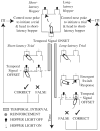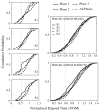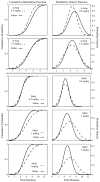Interval timing in genetically modified mice: a simple paradigm
- PMID: 17696995
- PMCID: PMC2649730
- DOI: 10.1111/j.1601-183X.2007.00348.x
Interval timing in genetically modified mice: a simple paradigm
Abstract
We describe a behavioral screen for the quantitative study of interval timing and interval memory in mice. Mice learn to switch from a short-latency feeding station to a long-latency station when the short latency has passed without a feeding. The psychometric function is the cumulative distribution of switch latencies. Its median measures timing accuracy and its interquartile interval measures timing precision. Next, using this behavioral paradigm, we have examined mice with a gene knockout of the receptor for gastrin-releasing peptide that show enhanced (i.e. prolonged) freezing in fear conditioning. We have tested the hypothesis that the mutants freeze longer because they are more uncertain than wild types about when to expect the electric shock. The knockouts however show normal accuracy and precision in timing, so we have rejected this alternative hypothesis. Last, we conduct the pharmacological validation of our behavioral screen using d-amphetamine and methamphetamine. We suggest including the analysis of interval timing and temporal memory in tests of genetically modified mice for learning and memory and argue that our paradigm allows this to be done simply and efficiently.
Figures





References
-
- Abner RT, Edwards T, Douglas A, Brunner D. Pharmacology of temporal cognition in two mouse strains. Int J Comp Psychol. 2001;14:189–210.
-
- Balci F, Moore H, Brunner D. Timing deficits in aging and neuropathology. In: Bizon JL, Wood AG, editors. Animal Models of Human Cognitive Aging. Humana Press; Totowa, NJ: in press.
-
- Bevins RA, Ayres JJB. One-trial context fear conditioning as a function of the interstimulus interval. Anim Lear Behav. 1995;23:400–410.
-
- Bevins RA, McPhee JE, Rauhut AS, Ayres JJB. Converging evidence for one-trial context fear conditioning with an immediate shock: importance of shock potency. J Exp Psychol Anim Behav Process. 1997;23:312–324. - PubMed
-
- Çevik MO. Effects of methamphetamine on duration discrimination. Behav Neurosci. 2003;117:774–787. - PubMed
Publication types
MeSH terms
Grants and funding
LinkOut - more resources
Full Text Sources
Molecular Biology Databases

